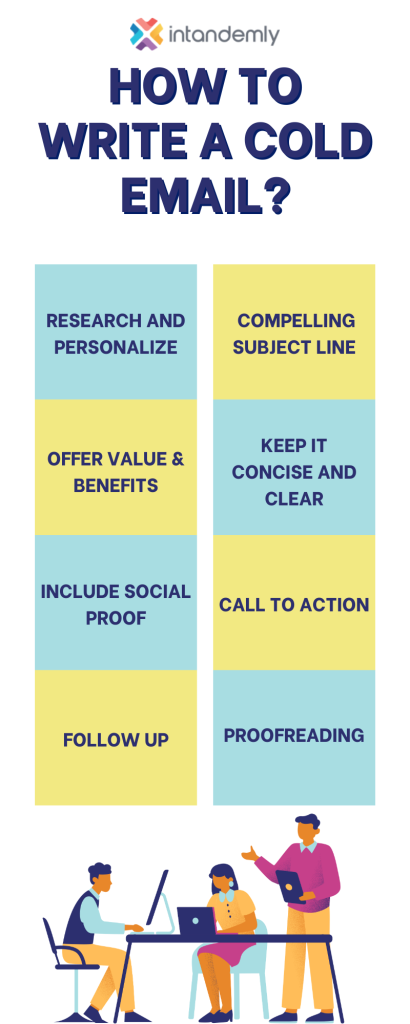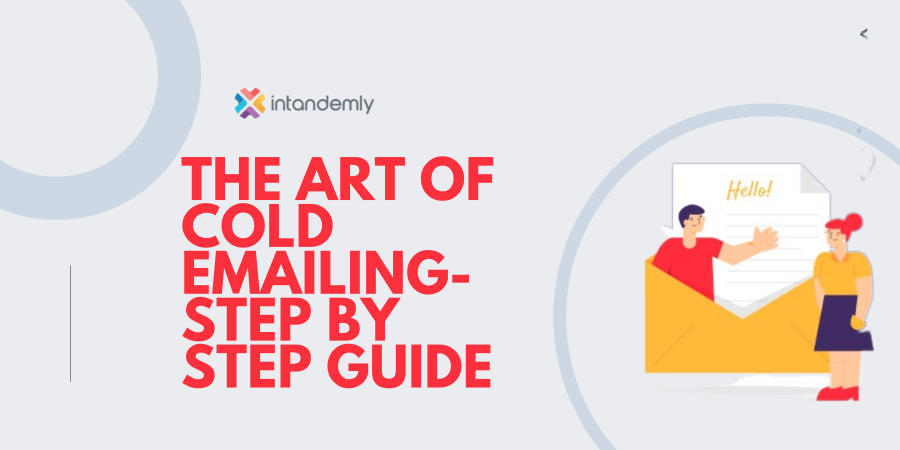What is Cold Email? Step by Step Guide-2024
Cold emailing is the process of reaching out to potential customers or partners who you have no prior relationship with. It can be a daunting task, but it can also be a very effective way to generate new leads and grow your business.
Introduction:
Cold emails have become a common method of communication for professionals across industries. Whether you are reaching out to potential clients, seeking job opportunities, or networking with industry experts, writing an effective cold email can significantly increase your chances of success.
In this blog post, we will discuss the key steps to write a cold email that stands out from the crowd, common mistakes to avoid, and some tips and tricks to make your cold emails more effective.
How to write a cold email? Step by step guide
When crafting a cold email, it is crucial to make a strong first impression and pique the recipient's interest. Here are some steps to help you write a cold email that stands away from the crowd:
- Research and Personalize: Before reaching out to someone, take the time to research and gather information about the person and their company. This will allow you to personalize your email and make it more relevant to the recipient. You can find information about your prospects on their website, social media, and industry publications.Mention specific details about their work, achievements, or interests to show that you have done your homework.
- Craft a Compelling Subject Line: 33% of people open emails based on the subject line.The subject line is the first thing the recipient sees, so make it attention-grabbing and concise. A subject line that clearly states the purpose of the email and creates curiosity will entice the recipient to open it.Avoid using generic or spammy subject lines. Instead, try to write something that is relevant to your target audience and that will pique their curiosity.These are a few lines which we used for our prospects.
- Congratulations! You achieved this month’s target
- Small Business? Big Impact!
- Offer value & benefits: Don't just start pitching your product or service right away. Instead, offer the recipient something of value, such as a free consultation, or a case study. This will show them that you're not just trying to sell them something, but that you're genuinely interested in helping them to succeed.Clearly communicate the value or benefit the recipient will gain by responding to your message. Highlight any common interests, shared connections, or ways in which your collaboration can be mutually beneficial. Show them how your email can solve a problem or fulfill a need they have.
- Keep it Concise and Clear: Long, wordy emails are often disregarded. Make sure your email is concise, clear, and to the point. Focus on the main objective of your email and avoid unnecessary details or jargon. Use bullet points or short paragraphs to break up the text and make it easier to read.Cold emails with 50-125 words tend to have the highest response rates.
- Include Social Proof:Incorporate social proof to build trust with the recipient. This could include customer testimonials, case studies, or mentions of notable clients you've worked with. This helps build credibility of the business.
- Call to Action:Tell the recipient exactly what you want them to do. Do you want them to reply to your email, schedule a demo, or visit your website? Include a clear call to action in your email so that it's easy for the recipient to take the next step.
- Follow Up:Sending a single cold email is often not enough. Craft a follow-up email to nudge recipients who haven't responded. Sending at least three follow-up emails can increase the response rate by 28%.
- Make it easy to respond: Proofread your email. Before you hit send, take a few minutes to proofread your email carefully. Make sure that there are no errors in grammar or spelling. You want to make a good impression on your recipients, so it's important to send a professional email.

Common mistakes to avoid while writing a cold email:
While writing cold emails, it is essential to avoid certain common mistakes that can hinder your chances of success. Here are a few mistakes to steer clear of:
- Generic and Impersonal Emails: Sending out generic emails that lack personalization can make your message appear spammy and uninteresting. Take the time to address the recipient by name and tailor your email to their specific needs or interests. Mention something specific about their work or recent achievements to show that you have taken the time to learn about them.
- Overwhelming with Information: Bombarding the recipient with excessive information or a lengthy email can overwhelm and discourage them from reading the entire message. Keep your email concise and focus on the most relevant and compelling points. Use brief examples or anecdotes to illustrate your ideas and make them more engaging.Avoid using all caps, excessive exclamation points, or spammy keywords in your subject lines or emails. This will make your emails look like spam and will likely be ignored.
- Neglecting Follow-Up: Many people make the mistake of not following up after sending a cold email. Following up shows persistence and allows you to reiterate your interest or proposal. Be polite and respectful in your follow-up emails, giving the recipient a gentle reminder about your initial message. Mention something specific from your previous email to jog their memory.
- Sending to Irrelevant Contacts:Sending cold emails to people who have no interest in your product or service is a waste of time and resources. Build a targeted list of contacts.Before you even start drafting your cold email, you must have a clear understanding of your target audience.
Tips and Tricks
To make your cold emails more effective, here are some tips and tricks to consider:
- Use a Professional Tone: Maintaining a professional tone is crucial in cold emails. Be polite, respectful, and avoid using overly casual language. Show your expertise and credibility to establish trust with the recipient. Use formal language and avoid slang or abbreviations.
- Use Email Verification Tools:Use email verification tools like to ensure the email addresses on your list are valid and won't bounce. By regularly verifying your email list, you can minimize bounce rates, increase email deliverability, and maintain a positive sender reputation.
- A/B Testing:Experiment with different email elements, such as subject lines, body content, and CTAs, using A/B testing to determine what works best.Test different subject lines to see which ones result in higher open rates. Test different content, messaging, and formatting to see what elicits the best response.Test different CTAs to determine which one leads to more clicks or conversions. This can include variations in wording and placement. Test the timing of your email sends to discover when your audience is most responsive.
- Automate Your Outreach: Consider using email marketing automation tools to schedule and manage your cold email campaigns effectively.This will ensure the timely delivery of your emails and also give reports and analytics of each campaign.
- Monitor Metrics:Monitoring key email metrics helps you gauge the effectiveness of your cold email campaigns: Some key metrics are Open Rates-to understand how engaging your subject lines are,Click-Through Rates-action based on your email content and CTAs,Conversion Rates: number of leads or sales generated from your cold emails,Unsubscribe Rate etc
- Learn from Feedback:Use the feedback to iterate and adapt your cold email strategy. Continuous improvement is key to success.Pay attention to responses, both positive and negative, to refine your approach continually.Pay attention to what recipients found appealing about your email, so you can replicate those elements in future campaigns.Analyze negative feedback to understand why some recipients were not interested or felt the email was irrelevant.
By following these tips and continually refining your approach, you can enhance the effectiveness of your cold emailing efforts, especially in the context of small businesses and B2B outreach. Cold emailing is an evolving process, so stay open to testing, learning, and adapting to achieve the best results.
Templates:
Template 1:
Subject :
Came across you magazine article!
Content :
Hey {{Contact.FirstName}} ,
I noticed in a recent HR Magazine article that you folks are introducing 2 new health plans this year.
If you're like the other companies we work with in the hospitality industry that are rolling out new plans, you might find it challenging to explain plan options to your employees in an easy to understand way WITHOUT putting them into sleep induced coma.
Since we're super passionate about ridding the world of benefits bewilderment, we put together a free 4 part video series that might help you explain your plans in Plain English while persuading more people to enroll in high deductible plans.
If you're interested, just reply and I'll send it along.
Regards,
[your name]
Template 2:
Subject :Remote coding
Content :
Hi {{Contact.Name}} ,
I read your article on volunteering your professional skills in Guatemala – it was really inspiring. I'm looking to travel more and you've got me thinking about incorporating volunteering when I do!
I have a software company trying to improve remote medical record coding.
I'm not looking to sell anything, but since you have so much expertise with remote coding, I'd love to get your advice on our product so we don't build the wrong thing.
If you're available, I'd love to chat for just 20 minutes – Thur or Fri morning.
Regards,
[your name]
Want more templates?
Conclusion
Writing a cold email that actually works requires careful planning, personalization, and attention to detail. By following the steps outlined in this blog post, avoiding common mistakes, and implementing the tips and tricks provided, you can increase your chances of getting a positive response. Remember, practice makes perfect, so experiment with different approaches and continuously improve your cold email writing skills. With time and effort, you will become more proficient at crafting effective cold emails that yield the desired results.
FAQs
Is cold emailing a good idea?
Is cold emailing a skill?
How many cold emails should you send?
It is also important to note that the quality of your cold emails is more important than the quantity. Take the time to write personalized, well-crafted emails that offer value to your recipients.
